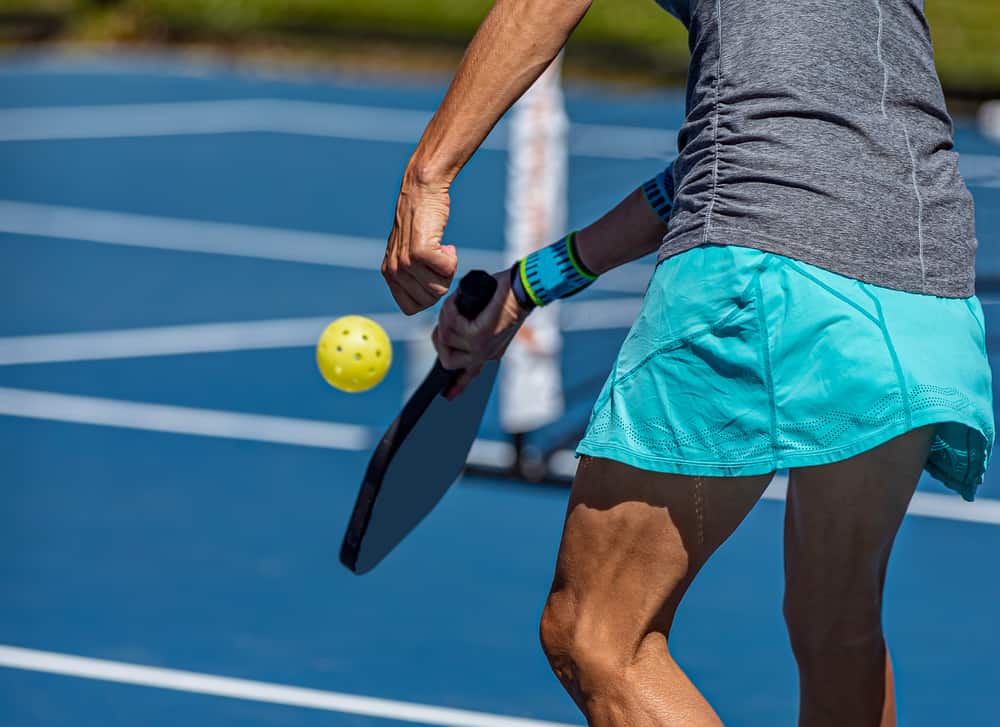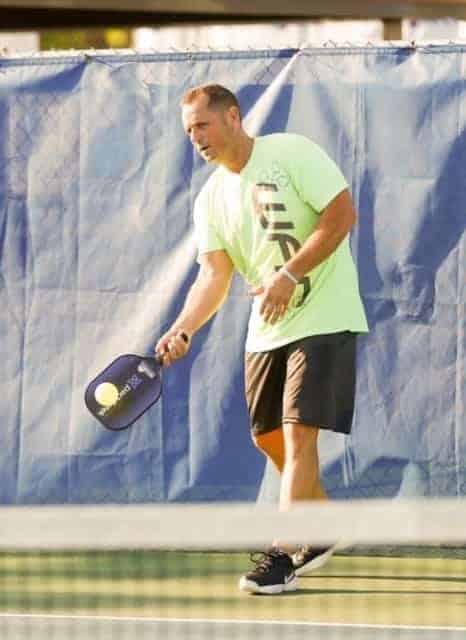Pickleball is a fun, friendly yet competitive activity enjoyed by all ages, from children enjoying an after-school activity to senior citizens playing a game in a retirement community. However, just like any other paddle sport, pickleball has several rules to follow pertaining to the serve to ensure a successful and productive game.
But don’t worry, you don’t have to read an entire book about pickleball to fully understand what the 3 rules of a pickleball serve are. I’ve got you covered.
The 3 rules of a pickleball serve are:
- Both feet must be behind the baseline when serving.
- You must serve with an underhand stroke below waist level.
- You must serve to the quadrant diagonal and opposite you.
Now that you can see serving in pickleball isn’t as complicated as you think, I’m going to elaborate on each of these 3 serving rules and what makes them an integral part of your pickleball serve and the game as a whole. I’ll also make sure you know the basics of a legal serve in pickleball, and then I’ll go over some techniques for a lethal, on-point consistent serve.
Editor’s Note: Looking for a simple, one-page sheet of pickleball rules you can easily point off? Well, I created one! Just click and print!
The One Paddle I Recommend For Serious Beginners – The Prince Response Pro
This paddle is perfect for beginners because it offers, in my opinion, the largest sweet spot of any paddle on the market right now! This is ideal for beginners wanting to play more pickleball because it allows “miss-hits” to still be on point. It’s also got loads of power and plenty of touch at the net.
Pickleball Serve Rule #1 – Both Feet Must Be Behind The Baseline When Serving
The image below is a good illustration of how to set up for a legal pickleball serve. Everyone sets up for a serve in pickleball a little differently but the general rules still apply. You can choose to serve from the middle or either corner of the baseline quadrant.
Even anywhere in between is legal.
Where you line up behind the baseline may depend on where your opponent is set up to receive your serve.

Both of my feet are behind the baseline. This is a legal serve.
It is okay for the ball and your paddle to be over the baseline as long as your feet are behind it.
When you’re playing pickleball, and it’s your turn to serve, you have to pay attention to where your feet are standing and how they are positioned.
Your pickleball serve “routine” is also something to keep in mind. You might bounce the ball twice before going into your serving motion. You might position the ball on the paddle and aim to where you want to the ball to go. Everyone’s pre-serve routine is a little different.
The trick is to find what feels comfortable to you and do it every time! Keeping the same pre-serve routine builds muscle memory and more importantly, allows your swing motion to become the same every time. Consistency is critical when serving in pickleball.
If you’re serving, both feet have to stay behind the baseline, but what is the baseline, and where is it exactly? It’s helpful if you understand the court itself and what all the lines painted onto the surface mean regarding the game.
Here’s a list of all the paremeters and lines in pickleball, where they are positioned, and what they mean:
- Sidelines: The sidelines are the lines on either side of both quadrants.
- Baseline: This is the line at the back of your team’s quadrants. You should stand with one foot behind this line when serving.
- Non-Volley Line: This is the line that marks the no-volley zone before the net. If you’re going to hit the ball while standing in the No-Volley Zone, it must be groundstrokes only. No volleying; hence the name.
- Centerline: The centerline is the line that separates the two quadrants on either side of the net. If you’re playing doubles, you and your team partner will each have your own quadrant assigned to you.
Pickleball Serve Rule #2 – You Must Serve With An Underhand Stroke Below Waist Level
The serve is one of the most important aspects of a game of pickleball. Not only is it the start of every point but, if you mess it up, you’re giving your opponent an easy side out and not allowing your team to even earn a point.
In pickleball, there’s a reason why the underhand stroke is the only acceptable method to serve your ball; and it has to do with serving below the waist level. An underhand stroke is conducted by moving your arm in an upward motion that cannot exceed the waist level or right at your navel when the paddle has contact with the ball.
The highest point of the paddle also cannot be higher than your wrist. This means the top of the paddle face cannot be aimed upward toward the sky above the line of your wrist. This keeps players from getting too aggressive with topspin serves.
If your serve has too much “over-the-top smash” action to it, it’s most likely not legal. But that doesn’t mean you can’t put spin action on the ball during a serve. You can, you’ve just got to come under the ball first. Once the ball is hit below your waist with your wrist down, you are allowed to come up and put a little spin on the ball.
As long as you’ve hit the ball below your waistline with your wrist starting downward before hitting the ball, it’s okay after the ball is hit, to come over it and add some topspin.
Where does the underhand pickleball serve come from?
The pickleball underhand serve comes from its parent game, badminton. Badminton has the same rules that require an underhand stroke serve, which is one reason why the games are similar in the way they are played.
When delivering your serve, it’s essential to keep in mind your form while performing your underhand stroke. While the paddle and ball do not weigh much, it’s still crucial that you move with your entire arm, starting from the shoulder when swinging your hand and paddle upward.
Click here for more simple tips and strategies.
This will give your ball momentum to send it in a sailing arc over the net and into your opponent’s space.
It’s also important to remember to keep your movements minimal when serving; don’t twist your body or move your feet. At first, rest your weight on your back foot, and as you swing your arm upward, move your weight to your front foot, helping to propel your body forward, matching the movement of your arm.
If you’re unsure about your serve, I suggest you practice your serving skills before playing a game with others. Set up some pickleball serving drills with a friend and see how close to the opposite baseline you can get. Drill this for 15 min and you’ll begin to get the hang of it and find some rhythm.
Pickleball Serve Rule #3 – You Must Serve to the Quadrant Diagonal and Opposite You
The final rule I want to go over is the direction you’re going to be serving. In pickleball, a serve is always directed to the section diagonal to you on the other side of the net.

Related: Looking for a bonus rule? Check out this little-known rule about pickleball serving you’ve never heard of!
Pickleball Serving Techniques
Now that you know the 3 rules of serving in pickleball, I want to go over a few techniques in serving that will help you improve your serve in no time.
Practice makes perfect. Whether you’re just starting out or you’re a seasoned player wanting to sharpen your skills, practice is always the key to success. If you see pickleball tournaments in your future, you’ll definitely want to make sure you’ve got a great serve and that you stick to the rules.
Choose which type of serve method works best for you.
There are two types of serves in pickleball. The first is the traditional serve where you hold the ball, swing the paddle behind you, and hit the ball out of your hand. The other is called a drop serve. This means that you’re dropping the ball from shoulder height, letting it bounce, then hitting it. The drop serve is new to pickleball and just became legal in 2021.
Other Serving Tips
If you’re still learning and aren’t sure which method feels more comfortable, try them both out and determine which one gives you more control. Control is vital because you’ll need to be able to strategically place the ball across the court without hitting it out of bounds. When you’re able to do this, you can then work on your aim, which ensures you hit the ball right at your target.
Speaking of the target, the best place to aim during a serve, especially if you’re a beginner, is either your opponent’s feet or the baseline. If your opponent is lined up inside or on the baseline; aim at their feet. This forces your opponent to move back in order to hit the return, making it a more difficult shot.
If your opponent is lined up behind the baseline, aim at the baseline itself and force them to hit a deep return.
Once you’ve mastered your preferred serving method, understand how to control your serve, and perfect your aim, you’ll be able to serve consistently in pickleball matches. And this will go a long way in winning more points.
In pickleball, serve consistency is crucial. Consistent, deep serves win more points than fancy serves with spin that are not on target.

3 Rules Of A Pickleball Serve – My Final Thoughts
To recap, the 3 rules of a pickleball serve that are most important are as follows:
- You must have both feet behind the baseline before serving
- You must hit the ball below your waistline with your wrist aiming downward on contact with the ball
- You must serve to the opponent in the diagonal quadrant opposite you
These three rules apply to any pickleball serve and once you’ve got these mastered, it’s easy, even for a beginner, to have a consistent and legal serve.
While I did give you some general serving technique tips, if you’re an absolute beginner, I recommend not getting fancy and choosing to just keep your serve deep and in bounds. Don’t overcomplicate it or get fancy.
If ripping your serves decreases the chances of them going over the net or staying in bounds, don’t do it. Keep it simple and keep it in play. That’s the best place to start for a pickleball serve.
Happy pickleballing!

Welcome to TheVolleyLlama.com. My name is Keith, I’m just a lover of all sports that involve a racquet, net and a ball. I played competitive high school varsity tennis, love racquetball and my whole family plays pickleball regularly. I started this website to help give people like you the basics to learn these wonderful games.


